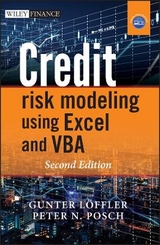
Credit Risk Modeling Using Excel and VBA
John Wiley & Sons Ltd (Verlag)
978-0-470-03157-5 (ISBN)
- Titel erscheint in neuer Auflage
- Artikel merken
GUNTER LOFFLER is professor of finance at the University of Ulm in Germany. His current research interests are on credit risk and empirical finance. Previously, Gunter was assistant professor at Goethe University Frankfurt, and served as an internal consultant in the asset management division of Commerzbank. His Ph.D. in finance is from the University of Mannheim. Gunter has studied at Heidelberg and Cambridge Universities. PETER N. POSCH is PhD student in finance at the chair of Gunter Loffler. His current research focus is on credit risk and financial econometrics. Peter studied philosophy and economics and holds a Diplom, M.Sc. equivalent, in economics from the University of Bonn.
Preface. Some Hints for Troubleshooting. 1 Estimating Credit Scores with Logit. Linking scores, default probabilities and observed default behavior. Estimating logit coefficients in Excel. Computing statistics after model estimation. Interpreting regression statistics. Prediction and scenario analysis. Treating outliers in input variables. Choosing the functional relationship between the score and explanatory variables. Concluding remarks. Appendix. Notes and literature. 2 The Structural Approach to Default Prediction and Valuation. Default and valuation in a structural model. Implementing the Merton model with a one-year horizon. The iterative approach. A solution using equity values and equity volatilities. Comparing different approaches. Implementing the Merton model with a T-year horizon. Credit spreads. Notes and literature. 3 Transition Matrices. Cohort approach. Multi-period transitions. Hazard rate approach. Obtaining a generator matrix from a given transition matrix. Confidence intervals with the Binomial distribution. Bootstrapped confidence intervals for the hazard approach. Notes and literature. Appendix. 4 Prediction of Default and Transition Rates. Candidate variables for prediction. Predicting investment-grade default rates with linear regression. Predicting investment-grade default rates with Poisson regression. Backtesting the prediction models. Predicting transition matrices. Adjusting transition matrices. Representing transition matrices with a single parameter. Shifting the transition matrix. Backtesting the transition forecasts. Scope of application. Notes and literature. Appendix. 5 Modeling and Estimating Default Correlations with the Asset Value Approach. Default correlation, joint default probabilities and the asset value approach. Calibrating the asset value approach to default experience: the method of moments. Estimating asset correlation with maximum likelihood. Exploring the reliability of estimators with a Monte Carlo study. Concluding remarks. Notes and literature. 6 Measuring Credit Portfolio Risk with the Asset Value Approach. A default mode model implemented in the spreadsheet. VBA implementation of a default-mode model. Importance sampling. Quasi Monte Carlo. Assessing simulation error. Exploiting portfolio structure in the VBA program. First extension: Multi-factor model. Second extension: t-distributed asset values. Third extension: Random LGDs. Fourth extension: Other risk measures. Fifth extension: Multi-state modeling. Notes and literature. 7 Validation of Rating Systems. Cumulative accuracy profile and accuracy ratios. Receiver operating characteristic (ROC). Bootstrapping confidence intervals for the accuracy ratio. Interpreting CAPs and ROCs. Brier Score. Testing the calibration of rating-specific default probabilities. Validation strategies. Notes and literature. 8 Validation of Credit Portfolio Models. Testing distributions with the Berkowitz test. Example implementation of the Berkowitz test. Representing the loss distribution. Simulating the critical chi-squared value. Testing modeling details: Berkowitz on subportfolios. Assessing power. Scope and limits of the test. Notes and literature. 9 Risk-Neutral Default Probabilities and Credit Default Swaps. Describing the term structure of default: PDs cumulative, marginal, and seen from today. From bond prices to risk-neutral default probabilities. Concepts and formulae. Implementation. Pricing a CDS. Refining the PD estimation. Notes and literature. 10 Risk Analysis of Structured Credit: CDOs and First-to-Default Swaps. Estimating CDO risk with Monte Carlo simulation. The large homogeneous portfolio (LHP) approximation. Systematic risk of CDO tranches. Default times for first-to-default swaps. Notes and literature. Appendix. 11 Basel II and Internal Ratings. Calculating capital requirements in the Internal Ratings-Based (IRB) approach. Assessing a given grading structure. Towards an optimal grading structure. Notes and literature. Appendix A1 Visual Basics for Applications (VBA). Appendix A2 Solver. Appendix A3 Maximum Likelihood Estimation and Newton's Method. Appendix A4 Testing and Goodness of Fit. Appendix A5 User-Defined Functions. Index.
| Erscheint lt. Verlag | 4.4.2007 |
|---|---|
| Reihe/Serie | Wiley Finance Series |
| Zusatzinfo | Illustrations |
| Verlagsort | Chichester |
| Sprache | englisch |
| Maße | 174 x 252 mm |
| Gewicht | 710 g |
| Einbandart | gebunden |
| Themenwelt | Informatik ► Grafik / Design ► Digitale Bildverarbeitung |
| Betriebswirtschaft / Management ► Spezielle Betriebswirtschaftslehre ► Bankbetriebslehre | |
| ISBN-10 | 0-470-03157-3 / 0470031573 |
| ISBN-13 | 978-0-470-03157-5 / 9780470031575 |
| Zustand | Neuware |
| Haben Sie eine Frage zum Produkt? |
aus dem Bereich



